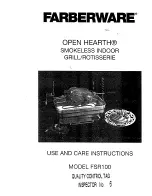
26
WHL-012 REV. 12.17.14
PART 6 – INSTALL THE CONDENSATE DRAIN
1. Due to its efficient design, the appliance produces condensate (water) as a normal by-product. This condensate is acidic, with a pH
level between 3 and 4. This condensate must be drained away from the appliance and disposed in accordance with all local
regulations.
2. Use corrosion-resistant materials approved by the Authority Having Jurisdiction (AHJ) to drain condensate. In the absence of an
AHJ, the included flexible plastic hose, or field supplied
½” PVC and CPVC drain pipe complying with
ASTM D1785, F441, or D2665 may be used. Cement and primer must comply with ASTM D2564 or
F493. For Canadian applications, use CSA or ULC certified PVC or CPVC pipe, fittings, and cement.
3. Local building codes may require an in-line neutralizer to be installed (not included) to treat the
condensate. Follow all the installation instructions included with the neutralizer. If a neutralizer is
installed, periodic replacement of the limestone (or neutralizing agent) will be required. The rate of
depletion of the limestone varies with usage of the appliance. During the first year of appliance
operation, check the neutralizer every few months for depletion.
4. Route the drain line to a nearby floor drain, laundry tub, or condensate pump.
NOTE:
If a nearby laundry tub is used as a disposal for waste water from the washing machine,
draining the condensate into this tub allows the soapy water discharge to neutralize the acidic
condensate.
5. An error will appear on the appliance display if condensate line is blocked. The appliance will not
operate with a blocked condensate line. It is extremely important to have this condition repaired by a
qualified service technician.
NOTE:
This appliance has an internal condensate trap that must be cleaned and maintained. See Maintenance section of this manual
for instructions on maintaining the trap.
Figure 15
– Condensate Piping with Condensate Neutralizer / Condensate Piping with Condensate Neutralizer and Pump
NOTES:
1. Condensate line must be pitched at least 1/4" per foot to properly drain. If this cannot be done, or a very long length of condensate hose is
used, you must increase the condensate line to a minimum of 1” ID and place a tee in the line after the condensate neutralizer to properly
reduce vacuum lock in the drain line.
2. Plastic pipe should be the only material used for the condensate line. Steel, brass, copper, or other materials will be subject to corrosion or
deterioration.
3. NEVER install condensate lines outside. It is very important that the condensate line is not exposed to freezing temperatures or any type of
blockage. Damages due to frozen or blocked condensate lines ARE NOT covered by warranty.
4. Support of the condensate line may be necessary to avoid blockage of the condensate flow.
Figure 14
– Internal
Condensate Trap
Summary of Contents for WBRCLP140F
Page 2: ...2 WHL 012 REV 12 17 14 ...
Page 38: ...38 WHL 012 REV 12 17 14 Figure 26 Electrical Wiring Diagram ...
Page 39: ...39 WHL 012 REV 12 17 14 Figure 27 Ladder Diagram ...
Page 73: ...73 WHL 012 REV 12 17 14 ...
Page 74: ...74 WHL 012 REV 12 17 14 ...
















































